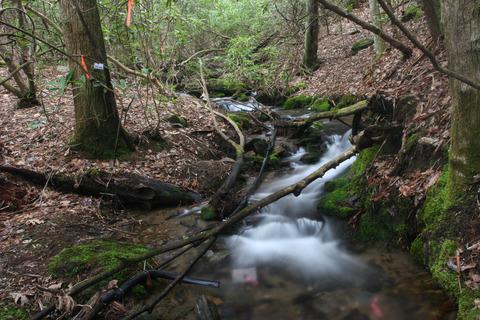当前位置:
X-MOL 学术
›
J. Anim. Ecol.
›
论文详情
Our official English website, www.x-mol.net, welcomes your
feedback! (Note: you will need to create a separate account there.)
Experimental N and P additions relieve stoichiometric constraints on organic-matter flows through five stream food webs
Journal of Animal Ecology ( IF 3.5 ) Pub Date : 2020-04-02 , DOI: 10.1111/1365-2656.13197 Lee M Demi 1 , Jonathan P Benstead 1 , Amy D Rosemond 2 , John C Maerz 3
Journal of Animal Ecology ( IF 3.5 ) Pub Date : 2020-04-02 , DOI: 10.1111/1365-2656.13197 Lee M Demi 1 , Jonathan P Benstead 1 , Amy D Rosemond 2 , John C Maerz 3
Affiliation

|
1.Human activities have dramatically altered global patterns of nitrogen (N) and phosphorus (P) availability. This pervasive nutrient pollution is changing basal resource quality in food webs, thereby affecting rates of biological productivity and the pathways of energy and material flow to higher trophic levels. 2.Here, we investigate how the stoichiometric quality of basal resources modulates patterns of material flow through food webs by characterizing the effects of experimental N and P enrichment on the trophic basis of macroinvertebrate production and flows of dominant food resources to consumers in five detritus-based stream food webs. 3.After a pre-treatment year, each stream received N and P at different concentrations for two years, resulting in a unique dissolved N:P ratio (target range from 128:1 to 2:1) for each stream. We combined estimates of secondary production and gut contents analysis to calculate rates of material flow from basal resources to macroinvertebrate consumers in all five streams, during all three years of study. 4.Nutrient enrichment resulted in a 1.5× increase in basal resource flows to primary consumers, with the greatest increases from biofilms and wood. Flows of most basal resources were negatively related to resource C:P, indicating widespread P-limitation in these detritus-based food webs. Nutrient enrichment resulted in a greater proportion of leaf litter, the dominant resource flow-pathway, being consumed by macroinvertebrates, with that proportion increasing with decreasing leaf litter C:P. However, the increase in efficiency with which basal resources were channeled into metazoan food webs was not propagated to macroinvertebrate predators, as flows of prey did not systematically increase following enrichment and were unrelated to basal resource flows. 5.This study suggests that ongoing global increases in N and P supply will increase organic-matter flows to metazoan food webs in detritus-based ecosystems by reducing stoichiometric constraints at basal trophic levels. However, the extent to which those flows are propagated to the highest trophic levels likely depends on responses of individual prey taxa and their relative susceptibility to predation.
中文翻译:

实验性的 N 和 P 添加减轻了对通过五个河流食物网的有机物质流动的化学计量限制
1. 人类活动极大地改变了全球氮 (N) 和磷 (P) 可用性模式。这种普遍的营养污染正在改变食物网中的基础资源质量,从而影响生物生产力的速度以及能量和物质流向更高营养水平的途径。2.在这里,我们通过表征实验中氮和磷富集对大型无脊椎动物生产的营养基础的影响以及主要食物资源在五种碎屑中向消费者的流动,研究基础资源的化学计量质量如何调节通过食物网的物质流动模式 -基于流食物网。3. 预处理一年后,每条河流接受不同浓度的 N 和 P 两年,导致每条河流具有独特的溶解 N:P 比(目标范围从 128:1 到 2:1)。在三年的研究中,我们结合了二次生产的估计和肠道内容分析,以计算所有五个流中从基础资源到大型无脊椎动物消费者的物质流率。4.营养丰富导致流向初级消费者的基础资源增加了 1.5 倍,其中生物膜和木材的增加最大。大多数基础资源的流动与资源 C:P 呈负相关,表明这些基于碎屑的食物网中普遍存在 P 限制。营养丰富导致大型无脊椎动物消耗更大比例的凋落物(主要资源流动途径),该比例随着凋落物 C:P 的减少而增加。然而,将基础资源引入后生动物食物网的效率提高并没有传播给大型无脊椎动物捕食者,因为猎物的流量在富集后并没有系统地增加,并且与基础资源流量无关。5.这项研究表明,全球氮和磷供应的持续增加将通过减少基础营养水平的化学计量限制,增加有机物质流向以碎屑为基础的生态系统中后生动物食物网的流量。然而,这些流传播到最高营养级别的程度可能取决于个体猎物分类群的反应及其对捕食的相对敏感性。这项研究表明,全球氮和磷供应的持续增加将通过减少基础营养水平的化学计量限制,增加流向以碎屑为基础的生态系统中后生动物食物网的有机物质。然而,这些流传播到最高营养级别的程度可能取决于个体猎物分类群的反应及其对捕食的相对敏感性。这项研究表明,全球氮和磷供应的持续增加将通过减少基础营养水平的化学计量限制,增加流向以碎屑为基础的生态系统中后生动物食物网的有机物质。然而,这些流传播到最高营养级别的程度可能取决于个体猎物分类群的反应及其对捕食的相对敏感性。
更新日期:2020-04-02
中文翻译:

实验性的 N 和 P 添加减轻了对通过五个河流食物网的有机物质流动的化学计量限制
1. 人类活动极大地改变了全球氮 (N) 和磷 (P) 可用性模式。这种普遍的营养污染正在改变食物网中的基础资源质量,从而影响生物生产力的速度以及能量和物质流向更高营养水平的途径。2.在这里,我们通过表征实验中氮和磷富集对大型无脊椎动物生产的营养基础的影响以及主要食物资源在五种碎屑中向消费者的流动,研究基础资源的化学计量质量如何调节通过食物网的物质流动模式 -基于流食物网。3. 预处理一年后,每条河流接受不同浓度的 N 和 P 两年,导致每条河流具有独特的溶解 N:P 比(目标范围从 128:1 到 2:1)。在三年的研究中,我们结合了二次生产的估计和肠道内容分析,以计算所有五个流中从基础资源到大型无脊椎动物消费者的物质流率。4.营养丰富导致流向初级消费者的基础资源增加了 1.5 倍,其中生物膜和木材的增加最大。大多数基础资源的流动与资源 C:P 呈负相关,表明这些基于碎屑的食物网中普遍存在 P 限制。营养丰富导致大型无脊椎动物消耗更大比例的凋落物(主要资源流动途径),该比例随着凋落物 C:P 的减少而增加。然而,将基础资源引入后生动物食物网的效率提高并没有传播给大型无脊椎动物捕食者,因为猎物的流量在富集后并没有系统地增加,并且与基础资源流量无关。5.这项研究表明,全球氮和磷供应的持续增加将通过减少基础营养水平的化学计量限制,增加有机物质流向以碎屑为基础的生态系统中后生动物食物网的流量。然而,这些流传播到最高营养级别的程度可能取决于个体猎物分类群的反应及其对捕食的相对敏感性。这项研究表明,全球氮和磷供应的持续增加将通过减少基础营养水平的化学计量限制,增加流向以碎屑为基础的生态系统中后生动物食物网的有机物质。然而,这些流传播到最高营养级别的程度可能取决于个体猎物分类群的反应及其对捕食的相对敏感性。这项研究表明,全球氮和磷供应的持续增加将通过减少基础营养水平的化学计量限制,增加流向以碎屑为基础的生态系统中后生动物食物网的有机物质。然而,这些流传播到最高营养级别的程度可能取决于个体猎物分类群的反应及其对捕食的相对敏感性。











































 京公网安备 11010802027423号
京公网安备 11010802027423号